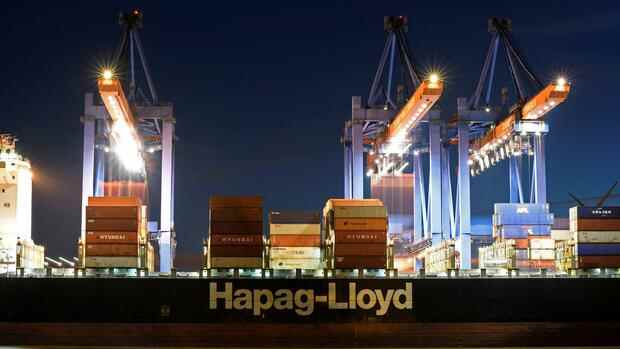Dusseldorf Hapag-Lloyd boss Rolf Habben Jansen has bad news for Germany’s importers. “There will be no relaxation in sea transport until the Chinese New Year celebrations at the beginning of February,” he said in a virtual press conference on Thursday morning. After that, the situation will improve again, but it will not return to normality in the entire year 2022 either.
112 container freighters are still jammed in front of the ports of the USA, as reported by Otto Schacht, the board member responsible for the sea freight business of the Swiss freight forwarding group Kuehne + Nagel. This continues to mess up the rhythm. “The situation will only get better,” he fears, “when the situation in front of the ports in Seattle, Los Angeles and Savannah relaxes.”
But it doesn’t look like that for the time being. The wave of strikes that began in October in the USA could also reach many ports in the coming weeks, logistics experts fear. The union density in the US ports is considered to be extremely high. Habben Jansen also refers to the usual winter storms at sea, which could lead to delays again this year.
Germany’s retailers are therefore worried about their Christmas business. Due to the ongoing delivery problems, they expect an average of 5.3 percent in sales, as the procurement specialist Coupa found in a survey.
Top jobs of the day
Find the best jobs now and
be notified by email.
The misery is due to irregularities in sea transport, which were largely triggered by the corona pandemic. At the beginning of 2020, Chinese exporters initially stopped their deliveries in order to get the infection under control. They then increased their capacities again massively, which led to the ports being overloaded for the first time.
At the end of March 2021, the six-day closure of the Suez Canal after an accident caused a similar effect; a few weeks later, the Chinese mega ports of Yantian and Ningbo closed one after the other due to outbreaks of corona. At the same time, sea containers became scarce because at times more than 350 ships worldwide were waiting for clearance in front of the ports. Freight rates went through the roof – and have hardly recovered to this day.
Container bottleneck has now been resolved
The shipowners have now got the shortage of steel boxes under control again. Hapag-Lloyd alone ordered more than 600,000 new containers. The traffic jams in front of the German Bight have also cleared, as Angela Titzrath, CEO of the Hamburg terminal operator HHLA, reported on Tuesday.
But the delays remain. Only 30 percent of all freighters currently reach the ports on time, according to a report from Sea Intelligence. At the beginning of 2020 it was more than 60 percent.
According to Habben Jansen, the reasons for this are a lack of workers in the ports and the stalled handling of ships, also due to the slow transport of containers to the hinterland.
Banks are getting back into the sea
The excessively long waiting times, in turn, reduce the efficiency of the ships used. “Where twelve ships used to be enough for a voyage service, we need 15 today,” complains the shipping manager. But using more container freighters doesn’t help, he believes. “Then there are just more ships in line.”
Ship operators are paying dearly for the inadequate transport capacities, as a shipping company study by PwC presented on Thursday shows. “There are significantly fewer liquidity bottlenecks than last year,” write the two study directors André Wortmann and Burkhard Sommer.
At the same time, the mood among the shipowners is exuberant. “Today 68 percent believe in growth again, and 75 percent of shipping companies are currently assuming that global cargo volumes will increase again,” explains PwC.
Surprisingly, according to the auditing firm’s observations, banks and other financiers are also getting back into ship financing, some of which had withdrawn completely from the sector after a massive wave of bankruptcies a few years ago.
The newly awakened interest is hardly surprising. In the second quarter of 2021 alone, the maritime consulting firm Drewry calculated, the industry earned 39.2 billion dollars before interest and taxes – eleven times the same quarter of the previous year. This could add up to $ 150 billion for the full year. “Never before in the 13-year history of the PwC shipowner study”, write its authors Wortmann and Sommer, “has there been such a strong change in mood within a year.”
More: Ningbo mega port fully operational again from September 1st
